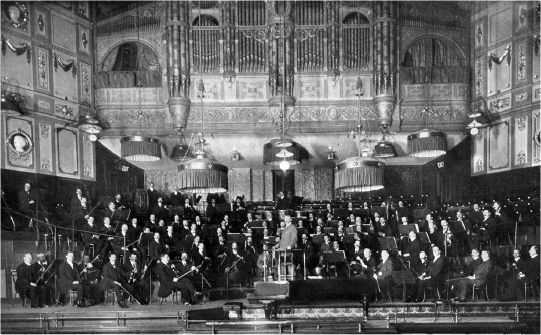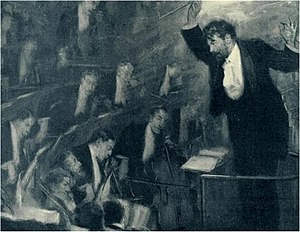
If you are a lover of Tchaikovsky's orchestral music then you are spoilt for choice with some of the recent releases on disc. The two that have featured most on my musical radar seem to have been well co-ordinated in their release timings. One combines Tchaikovsky's fourth and fifth symphonies while the other features his rather less well-known first, second and third symphonies. The curious thing is that these discs have been released at the same time by two of London's 'rival' orchestras, the LPO and the LSO, respectively.
Let me tell you, you will not regret purchasing either of them. In fact, I would go as far as suggesting that they are essential listening for those who think they know their Tchaikovsky symphonies. I do not imagine for a moment that the two orchestras communicated about the timing of the release of these discs but the fact that there is no overlap allows us to enjoy these highly distinctive readings without direct comparison.

Since my 'thing' is orchestral sound, it is interesting to note the difference between the recorded sound of these two wonderful orchestras. Clearly, neither orchestra records in halls noted for their acoustic brilliance. Nevertheless, the engineers recording in the Barbican and Royal Festival Halls have become adept at making the most of them. The two conductors here have cultivated very different orchestral soundworlds from their respective orchestras.
The LPO under Jurowski have a more realistic 'concert hall' sound on their disc with a better overall balance. They have a wonderfully dark and 'chilly' sound that better suits the darker, later symphonies. The LPO brass are clearly very good but they are never spotlit in the recordings for the sake of it in these works where many a conductor has been content to simply let these sections rip in order to get the most thrills. The string sound is fine but relatively lean sounding, which actually makes the most tricky of figurations sound like very little effort indeed was required to execute them. One of the secrets to the success of these readings is Jurowski's intelligent musicality in somehow making every line of counterpoint heard. So often one hears important string lines in these works come to the fore and simply disappear, which curtails the wonderful musical logic contained within.
Gergiev's LSO have a less distinctly 'Russian' sound and we hear a much 'fatter' string sound. How different an orchestra they are to that which we hear in those discs from the 'golden years' of the 60s and 70s when audiences were treated to Tchaikovsky symphony cycles under, say, Dorati and Markevich. The virtuosity remains, of course, but the string sound is muscular and very much 'Central European'. We have much to thank Sir Colin Davis for in that respect. May he get well soon. This full sound helps to add weight and credibility to these works that lie somewhere on the scale between masterpiece and jolly good romp. I tend towards thinking of the former, particularly in the case of the first symphony. Besides, it's about time that these earlier pieces had the 'luxury' treatment!
Common to both these orchestras is their orchestral layout with antiphonal violins and powerhouse double bass sections underpinning everything from the centre of the orchestral picture.
The word 'lugubrious' sprung to mind when I was listening to the readings of the first three symphonies. When I heard the radio broadcast of the first symphony I remember feeling that the slow movement was taken far too slowly. On hearing it on disc it sounds quite right - perhaps they went for the other take! Whatever one feels about the tempo, we are given time to really enjoy the lovely string sound (close up and vivid in the Barbican) and the hauntingly beautiful wind solos - lovingly indulged here. The real climax of the whole piece is to be found in this movement and it is given to the finest effect I have heard on disc. Goose pimples are guaranteed as the horns blast away the lonely melody above tremolando strings. I wondered if the horns may have been spotlit in the recording until I realised that the rest of the orchestra was being held back until finally letting rip moments later. Just try it! The finale really is terribly exciting and the 'liveness' is fully evident. Like Jurowski in his earlier release of this symphony, Gergiev takes Tchaikovsky's tempo markings quite literally in the transition from the andante to the main allegro, even if this seems to jar the flow a little. It is something I have become accustomed to.
If the second and third symphonies seem less remarkable it is not because of any lack of commitment on the orchestra's and conductor's part. They are highly enjoyable but, ultimately, less inspired works. Nevertheless, they demand to be known. What is interesting about this reading of the third is that it was recorded while the orchestra were on tour in the Tonhalle, Zurich. So, a rare chance to hear an LSO Live recording outside of the confines of the concrete Barbican!
I have never made a secret of my loyalties when it comes to British orchestras. The LSO has always been my favourite. However, if I had to choose between these wonderful discs I would have to opt for the one by my second favourite London orchestra, the LPO. Perhaps it is because I love the darker fourth and fifth symphonies more than Tchaikovsky's earlier ones. Still, I have heard plenty of uninspiring readings of these works. Jurowski is surely one of the most intelligent and interesting of today's more famous young conductors and he engages with these works with unflinching intensity. That is not to say that there is any over-emoting, there is plenty enough anxt and emotion in these works without the need to point these up.
My earlier point about counterpoint is an important one in these readings. Every line is heard, giving these highly contrapuntal works a sense of remorseless intensity and tragedy. Jurowski does not hold back, either, in terms of tempo. The tempi in the fifth symphony, in particular, are swifter than I have heard for quite some time. There are no happy endings to be found in these readings either. After a lithe and exciting final movement, the final three chords are ground out in a broader tempo suggesting quite the opposite of a victory. Jurowski suggested that he found more darkness in these works than others have when he was discussing them around the radio broadcasts. That Jurowski imbues these works with such a tragic intensity is no surprise given that he has also gifted us one of the most exciting renditions of Mahler's 'Resurrection' symphony ever on disc.
The reading of the fourth symphony is probably the most successful of all those discussed so far. The tempo of the first movement is just 'right'. It is in no hurry and yet never feels laboured. The second movement is definitely forward moving but with wonderfully musical phrasing, particularly in the opening plangent oboe solo. The relaxed tempo of the scherzo again feels just right when so many conductors feel the need to see just how far they can push their string players in the pizzicato perpetuo! The finale positively whizzes by and leaves the virtuosity of this fabulous orchestra beyond any doubt. There is no victory to be found at the close here, either, which is fine by me.





